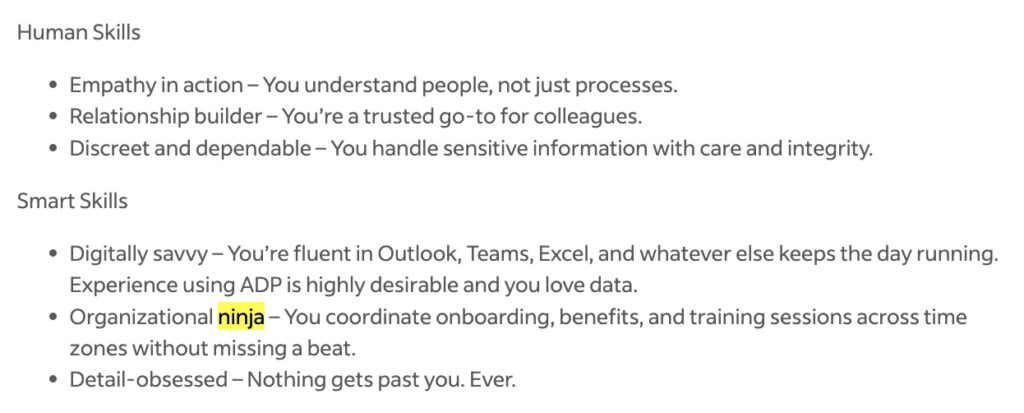- Last Week I Had a Viral LinkedIn Post — But Why? (And What TA Folks Can Learn From It) - December 8, 2025
- Job Description Process Improvement: How One Workflow Fix Saved 1,200 JDs from Chaos - December 4, 2025
- Affordable Job Description Management Software (That Still Do the Job Right) - November 19, 2025
I’ve read some job postings that gave me the “ick”. Like, actual secondhand embarrassment. That’s the feeling we’re talking about today.
I’ve seen some cringeworthy job postings that sound like a middle schooler trying to impress their cool cousin. Others just haven’t evolved since 1998. And the worst part? Candidates notice. They roll their eyes, they screenshot it, and they share it in group chats as a warning.
The Usual Suspects in Cringeworthy Job Postings

1. The “Rockstar/Ninja/Unicorn” Language
Still showing up. Still bad. When you say you’re looking for a “coding ninja” or “marketing rockstar,” you’re not making the job sound fun; you’re making it sound unserious. Worse, it’s alienating. It tells people you’re not really sure what you want, just that you want someone magical to fix it all. We wrote about how these and other buzzwords can hurt your JDs.
2. The “Must Thrive in a Fast-Paced Environment” Cliché
This one’s a red flag wrapped in beige. What does “fast-paced” mean? Tight deadlines? Unrealistic workloads? Constant fire drills? Be specific. Candidates aren’t allergic to challenge—they’re allergic to vagueness and burnout.
3. “Work Hard, Play Hard”…Just No
We get it, you have a ping pong table. This phrase is a relic. It usually signals a lack of boundaries or a culture that rewards overwork. Instead, talk about how your team supports balance, not burnout.
4. Gendered or Biased Language
Words like “aggressive,” “dominant,” or even “competitive” can skew male. On the flip side, words like “supportive” and “nurturing” can be coded as female. Neither is inherently bad, but together they shape who sees themselves in the role. This post shows you how can you be more gender-neutral in your job postings . Tools like Ongig help flag and fix this automatically.
5. “Must Have 10+ Years of Experience in a Tool That’s Only Been Around for 5”
This one’s more hilarious than cringey, but it still happens. When you reuse templates or don’t validate requirements, this kind of thing slips through. And it chips away at your credibility. Here’s how to fix your job requirements.
What Cringeworthy Job Postings Cost You
Every one of these phrases makes your posting look less professional or just outdated. Candidates judge your culture based on your job ads. And good candidates? They scroll right past.
It also hurts inclusion. For example, Harvard Business School research found that vague job ads caused qualified women to apply 25% less often than men—but when the job requirements were made specific, women applied even more often than men.
Canva’s analysis of job postings also found that jargon-heavy language turns off younger and underrepresented talent. And research from the University of Florida shows that too much jargon in workplace messaging hurts clarity and trust—especially among early-career professionals.
Here are some great examples of inclusive job descriptions that make a difference: https://blog.ongig.com/diversity-and-inclusion/inclusive-job-descriptions/
How to De-Cringe Your Job Postings
Start with Real Language
Write like a human. Be specific. If the job has tight deadlines, say that. If collaboration is key, describe what that looks like. Use structured JD templates to help.
Review for Bias
Use tech (like Ongig) or a peer review process to spot gender-coded words or overused corporate jargon. It makes a difference.
Keep It Updated
If you’re copying and pasting JDs from 2017, stop. Review them quarterly, especially for high-volume roles. Job markets evolve, and your content should too.
Test with Real People
Send your JD to someone outside your department and ask: “Would you apply to this? Does anything sound off?” Fresh eyes catch cringe.
What Good Looks Like
A great JD is clear, inclusive, and specific. It sets expectations without puffery. It respects the candidate’s time. And it reflects your brand—not your ATS’s default template.
The next time you post a job, read it out loud. If you cringe, your candidates will too.
Why I Wrote This
I wrote this because job postings are often a candidate’s first impression of your company. A cringeworthy one drives great people away. Ongig’s software helps clean up the language, structure, and formatting of job descriptions so they actually do their job: attract top talent. Request a demo if you’re ready to stop the scroll and start converting candidates.
FAQs
What makes a job posting cringeworthy?
Overused buzzwords, unrealistic requirements, or outdated slang make postings feel inauthentic or unprofessional.
How do I know if my job postings are outdated?
If you’re using phrases like “rockstar” or templates older than your phone, it’s time for a refresh.
Does job posting language affect inclusion?
Yes. Biased or vague language can discourage diverse talent from applying. Inclusive wording expands your reach.
Can software really fix this?
Absolutely. Ongig flags problematic language, suggests improvements, and helps keep your postings on-brand and bias-free.
Is it okay to be funny or casual in job postings?
Yes—if it aligns with your culture and doesn’t come off as forced. Avoid trying too hard. Clarity over cleverness.
